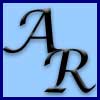|
History menu >
About Norman May's Studio and its founder
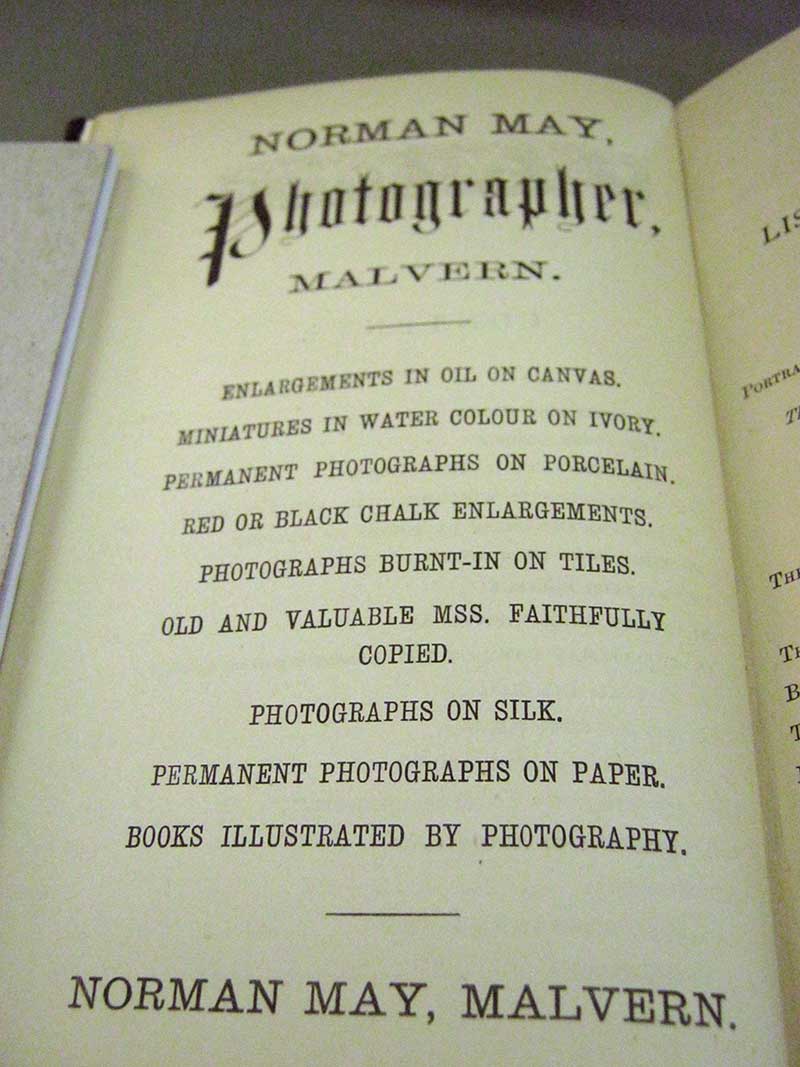 Contents Contents
Overview
Life of Norman May
Freemasonry
Death of Norman May
Francis Charles Earl
(predecessor)
Edwin Drury Stowe
(business partner)
John William Beaufort
(business partner)
Norman May's Guide to Malvern
More about Norman May's family
Norman May's Studio
References
While we were transcribing a section of the burial
register of Great Malvern cemetery for the Malvern Family History Society
(ref 1) we
came across the name John Norman Lindley-Norman, a photographer, who was
buried on 22nd June 1889 aged only 37 years.
Being interested in Victorian photographers we decided to
try and find out more about him with no success, until we stumbled across an
entry in the National Probate Calendar (ref 2) which stated he had been formerly
known as Norman John May. That rang a bell as many photographs of schools in Great
Malvern bear the imprint of Norman May's Studio, and it
seemed likely that he was the founder. Norman May's photographic studio was
first located in Church Street, Great Malvern, at what is today numbered 39.
A business bearing Norman May's name continues to trade, more than
one hundred
years after his death.
From Trade directories we have found other photographers
Norman would have known. Francis Charles Earl whose shop Norman may have
taken over; Edwin Drury Stowe who was in partnership with Norman circa 1879;
and John William Beaufort who was Norman's business partner
at the time of his death. In addition to Norman, we have written a few words
about these other early photographers, and about his family, several of whom
seem to have been involved with the dyeing and glazing of fabric.
From the census, we think that we have discovered
Norman's parents, brothers and a sister but some aspects of his life remain
a mystery; do let us know if you can tell us more about either him or his
family.
You can
click here to view a related web page listing some other artists and
photographers with a connection to Malvern
Norman John May was born In Cowgate Street, in the St
Paul's district of Norwich, Norfolk on 13th October 1851 (ref 3) the son of John May, then a
schoolmaster, and Hannah Priscilla Harris.
This was a time when photography was in its infancy.
During Norman's lifetime photographs were mostly taken on glass plates
coated with a light sensitive solution, which needed processing using
possibly
dangerous chemicals in a darkroom or portable tent.
Norman first appears in the census in 1861, aged 10 years, living
with his parents in Cambridge (ref 6).
We have not found Norman in the 1871 census and he is
next recorded in the Post Office directory of 1879 when he is a partner in
the photographic firm May and Stowe, with offices in Worcester and Malvern. The London
Gazette records that Norman's partnership with photographer Edwin Drury Stowe was
dissolved by mutual consent in August 1879.
Read more about E Drury
Stowe below.
The Great Malvern section of a Worcestershire Trade directory of 1880
(ref 7)lists:
May Norman, miniature painter on ivory, porcelain etc,
The Studio, Gazebo House, Church Street.
By 1881 his business had expanded to include photography, probably because
many wealthy people who came to Malvern for the water cure would have liked,
and paid, to have
their portrait taken.
We were very fortunate to be sent an example of
portraiture by Norman May's Studio by photographer and collector Steve Fox
of Havant in Hampshire (ref 14). He had acquired the photo from an antique shop in
Emsworth which is a small village near Chichester on the south coast.
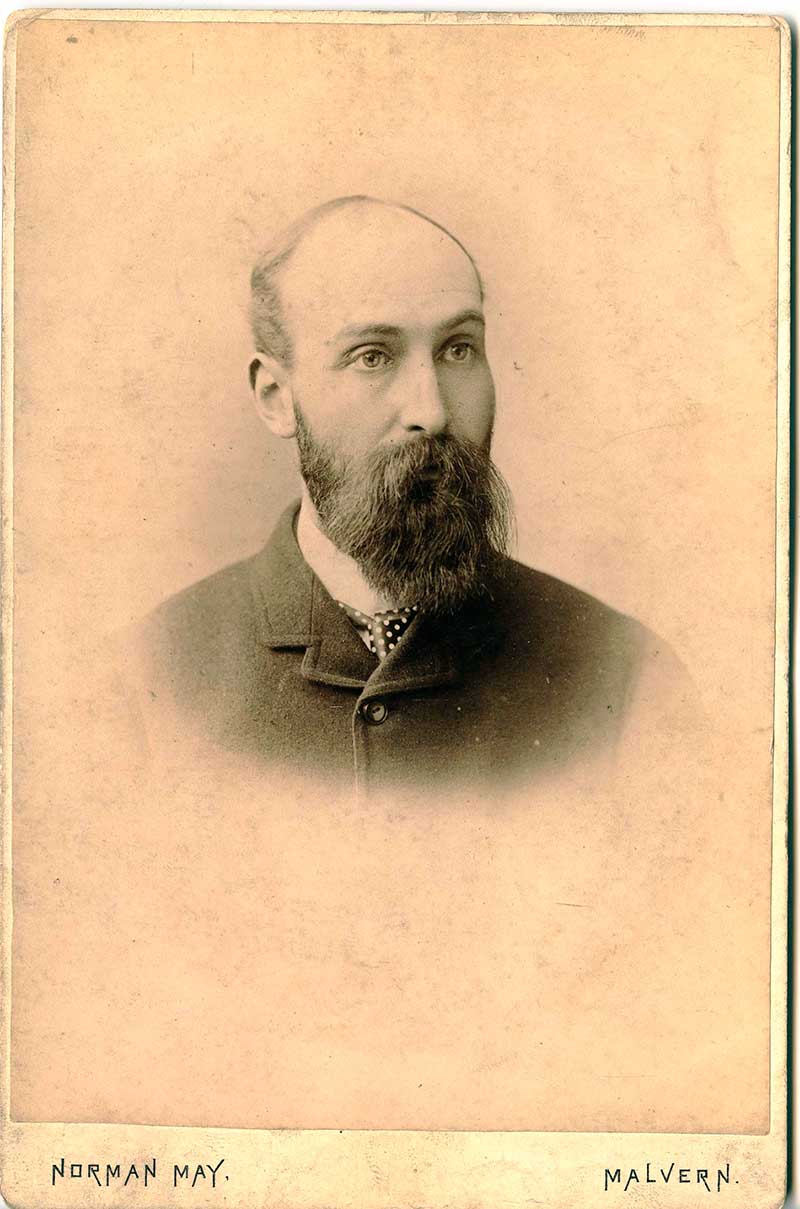
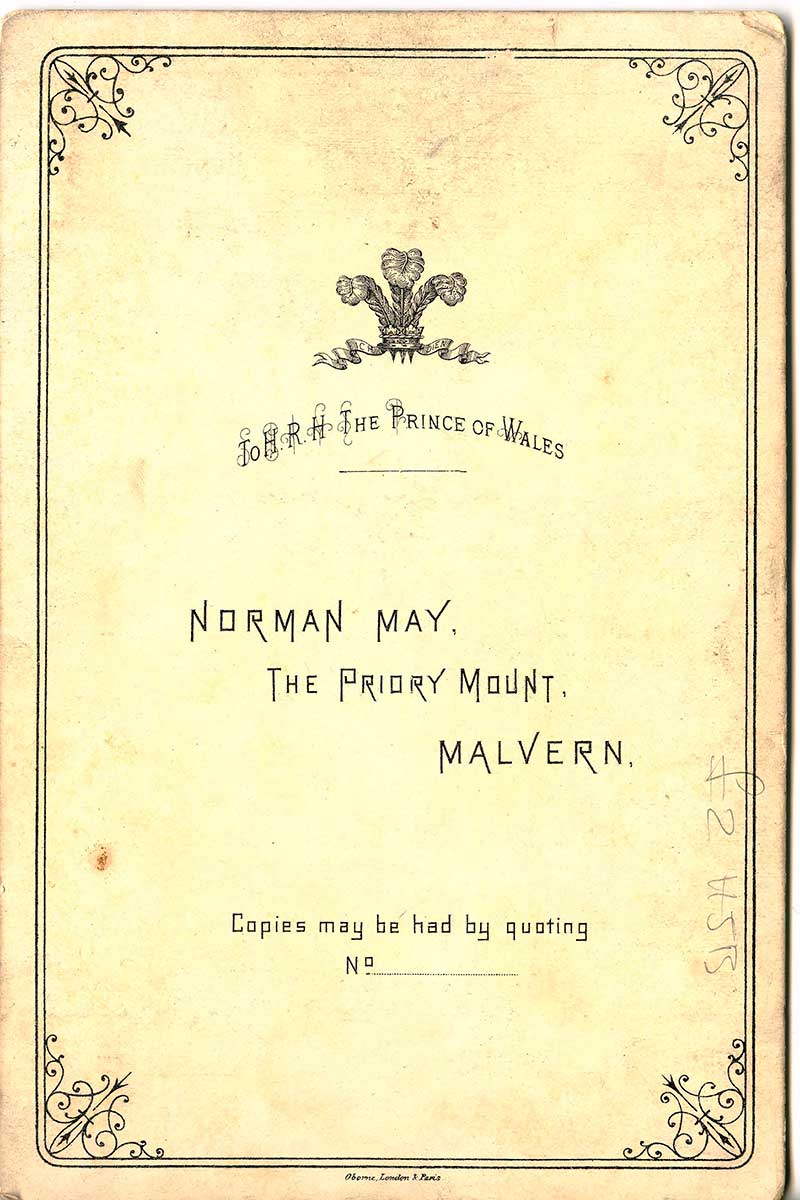
Portrait of a man, circa 1880s, courtesy of Steve Frost
The rear of the photograph is inscribed:
To HRH The Prince of Wales
Norman May
The Priory Mount
Malvern
Copies may be had by quoting
No (blank)
The bottom of the card is marked in small writing,
Oborne London and Paris
Oborne was one of many suppliers of photographic card;
one source suggests that photos bearing the imprint Oborne mostly date
between
1876 and 1887.
(The firm may have been owned by Edwin Cecil Oborne (1843
- 1916). The 1881 census recorded him as a photographic stationer
living at Ryde Vale Road, Streatham, while trade directories indicate his business, as a photographic mount manufacturers and photographic
paper-makers, was at 26 Red Lion Square, Holborn. Late in life, Edwin
married Sophia Wirdnam or Hall, in 1883. The 1891 census recorded Edwin as a
wholesale export stationer. By 1901 he was living on own
means, so possibly retired; his business was at some stage taken over by Edmund Alfred Ward, who, trading as Edwin Oborne and
Co, went bankrupt in 1910, ref 15).
Do tell us if you know who the bearded gentleman in the
portrait above might be.
Two further photos were copied to us by Dawn Heuston in
Canada who found them in a box of photos purchased at auction. Perhaps the
photos had been posted to a relative who had emigrated to Canada, then
passed down their family, and eventually lost in a house clearance. Have you
see the originals of these photos?
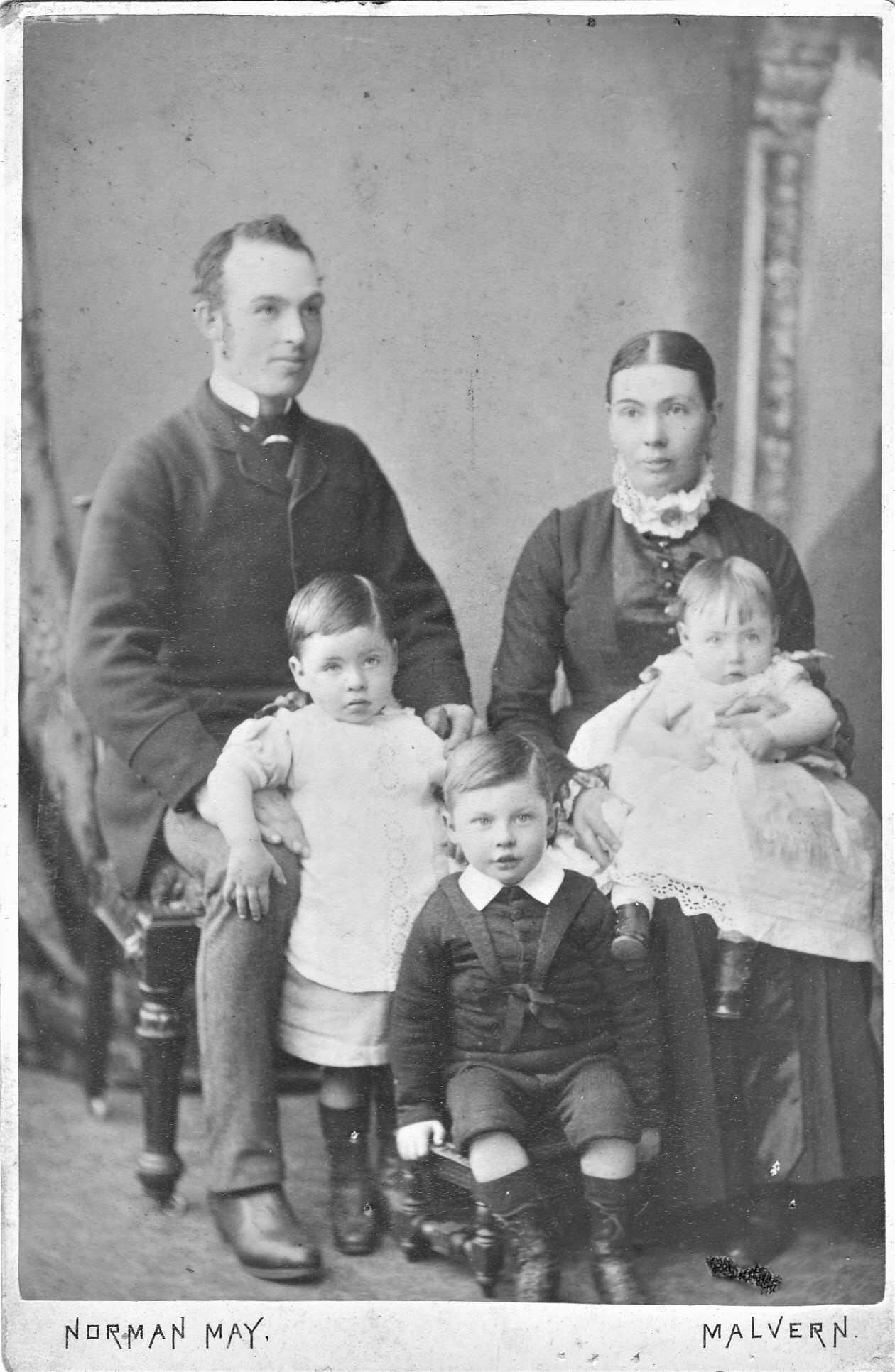
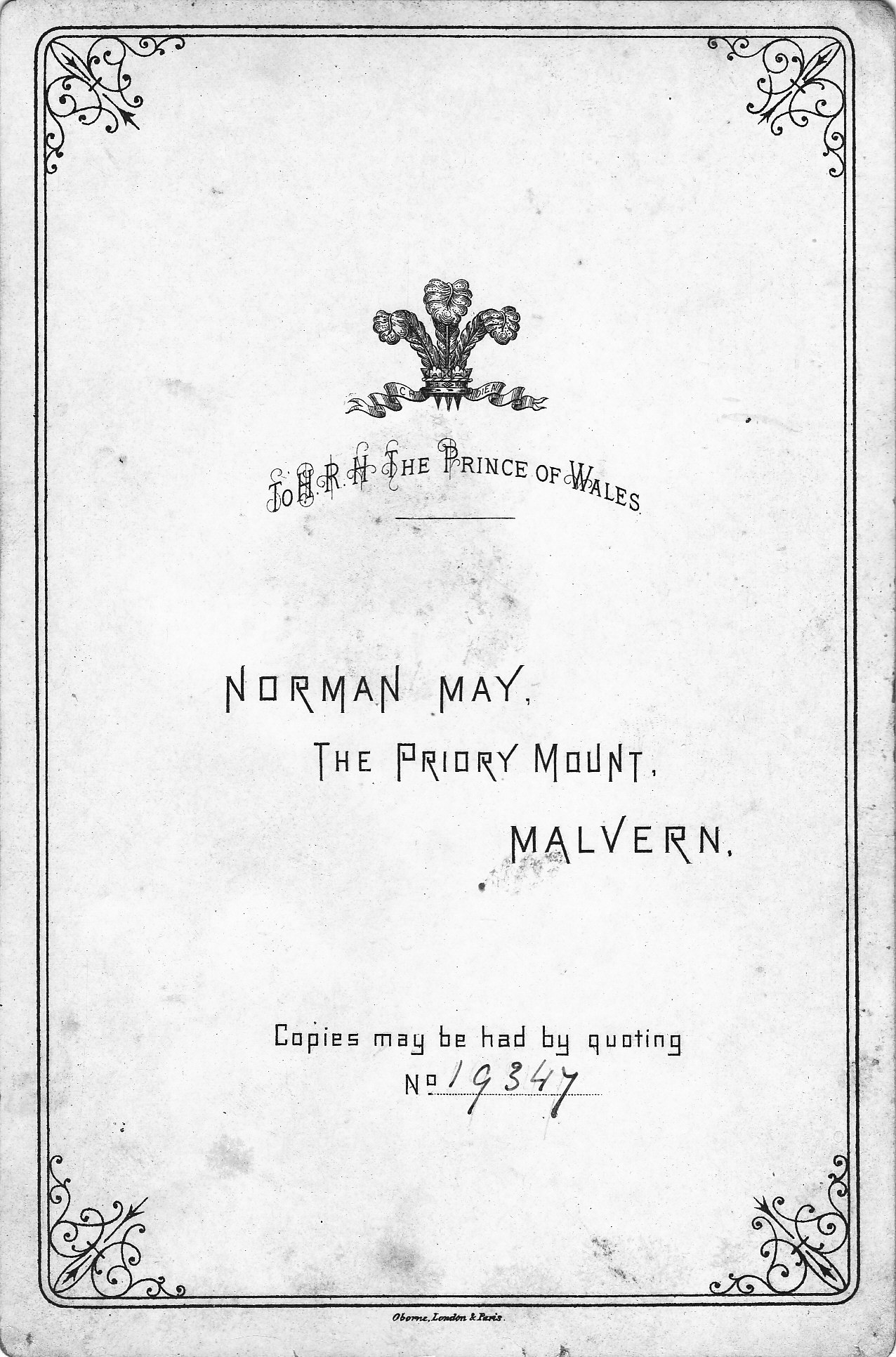
Photo of a couple with three children circa 1885
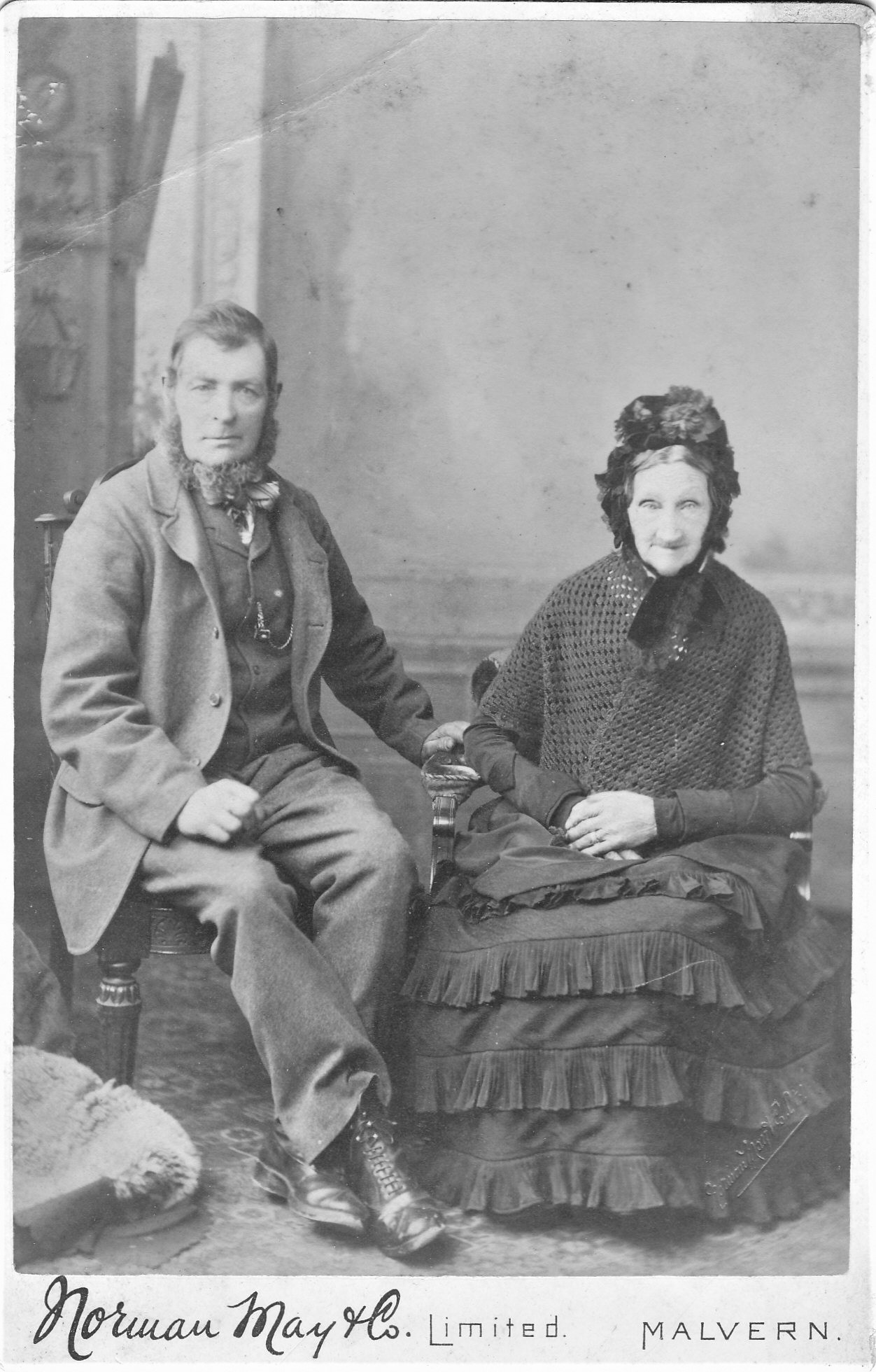
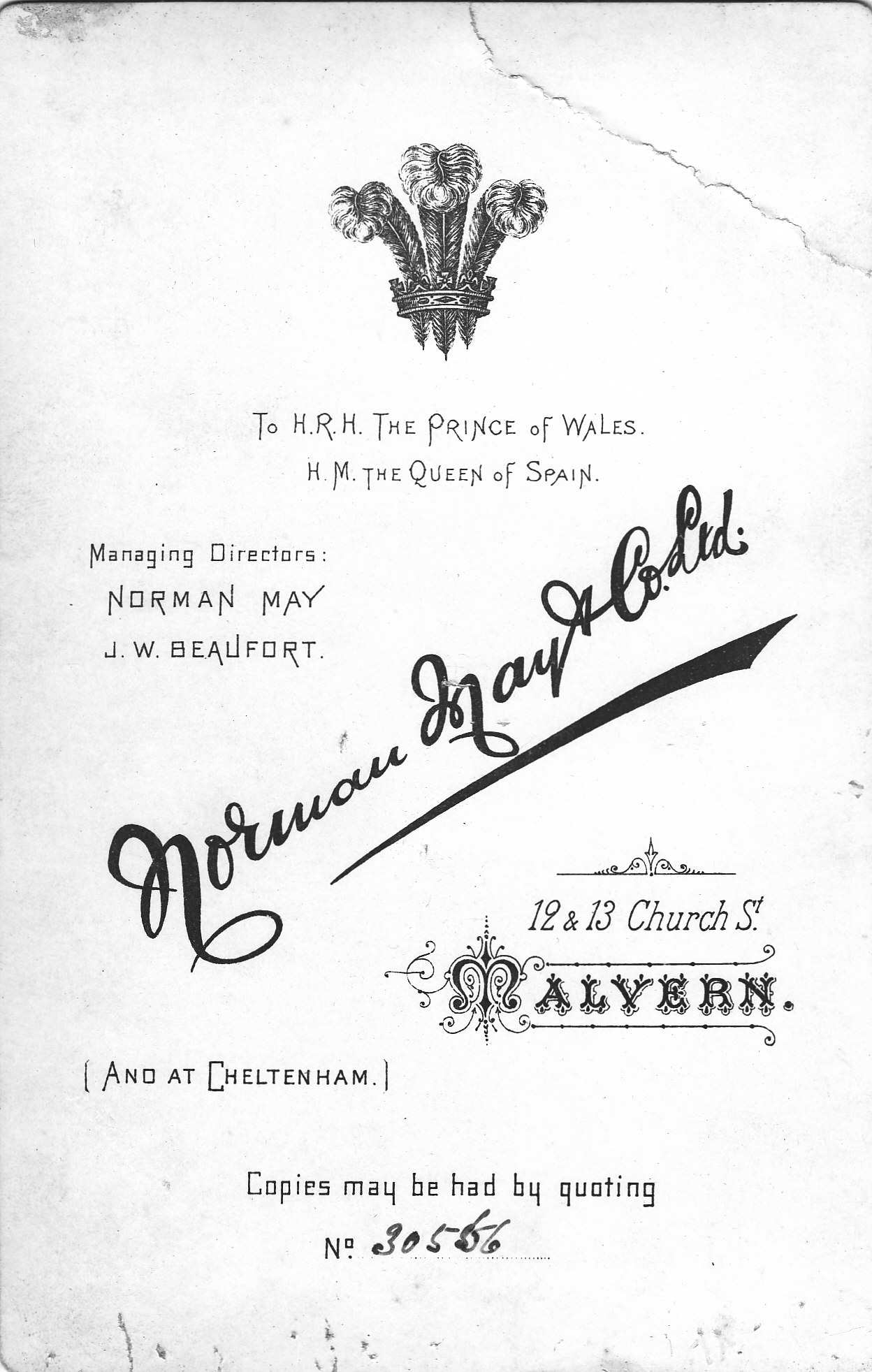
Photo of a middle aged man and possibly his mother circa
1889
Do please let us know if you think you can identify the
people in these photos and if they relate to your family.
The back of the second photo describes the managing
directors as Norman May and JW Beaufort and mentions another branch at
Cheltenham.
John
William Beaufort, who had changed his surname from Boocock, joined
Norman May about 1889, the year Norman May died.
The 1881 census provides further information about Norman:
Norman May aged 29, born Norwich about 1852, photographic
master, employing 2 men, 1 woman and 2 boys, address 2 Priory Mount, Church
Street, Great Malvern. Wife Eliza May aged 24, born Birmingham, Warwickshire.
Priory Mount is recorded in the census next to Gazebo
House, and it was towards the top of Church Street, just below the present
Boots the Chemist. In recent times the shop was a draper's named Sherwoods
but it is now a boutique named Juno, see shop-front below.
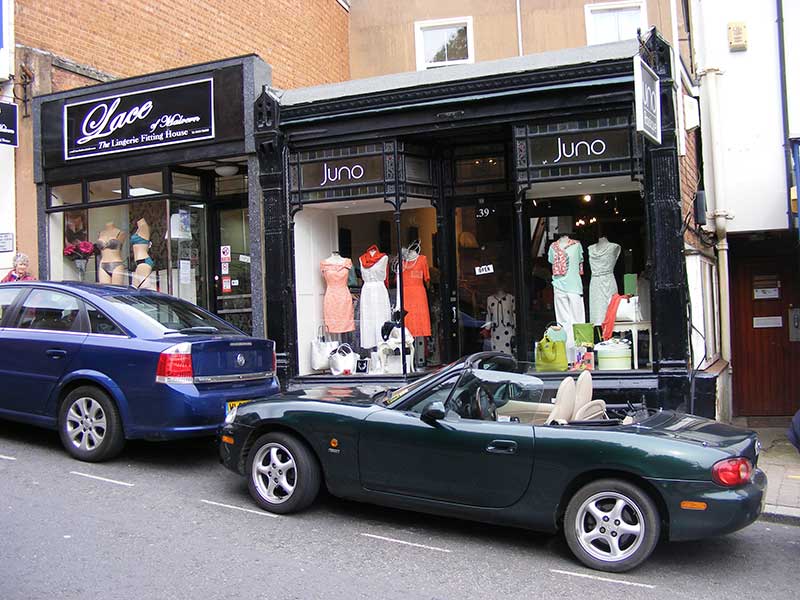
'Juno Boutique' in 2016 once the site of Norman May's
Studio
The original Victorian shop front of Norman Mays
Studio continues to be well preserved by the owner of the present business which is
featured in the January 2016 edition of Malvern Civic Society's newsletter.
Traces of Norman May's name can still be seen on the
threshold as you enter the shop.
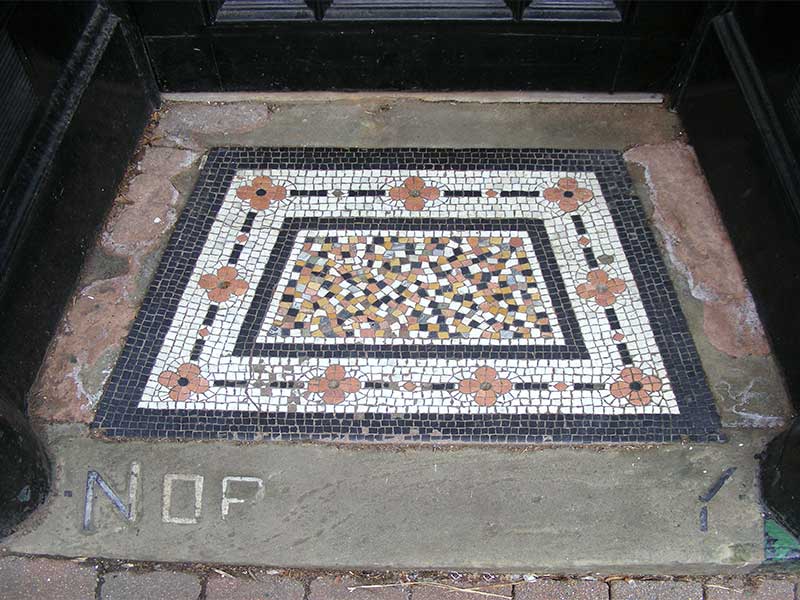
The owner of the shop very kindly showed us the fine
stained glass in the window lights above the stairs - remember in those days
there was no electricity, and natural lighting would have been an important
feature.

One perhaps begins to appreciate the ambience Norman May
must have created in his studio.
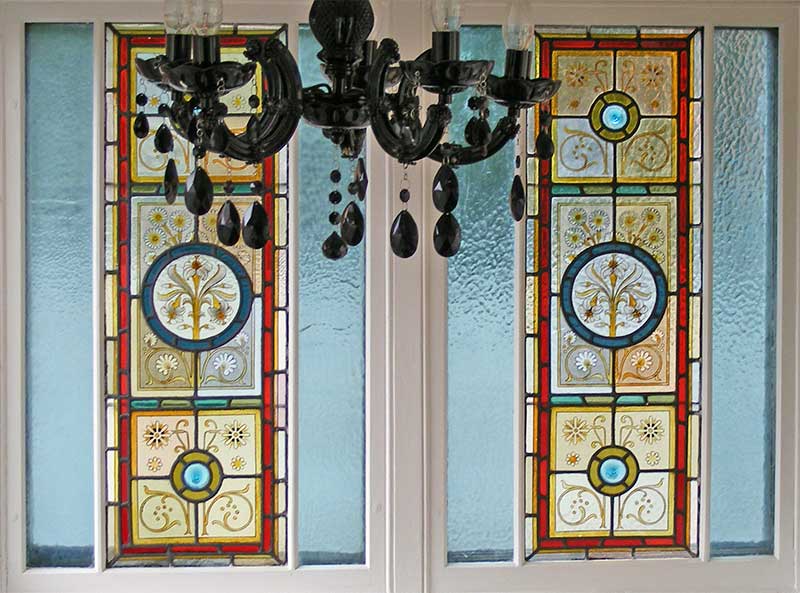
Close up of stained glass window
When Norman May first came to Malvern circa 1879, Priory Mount
was
one of a pair of terraced houses set back from the pavement by a garden and
stone wall, and you will see that the shop front has been extended across
the garden right up to the edge of the pavement - if you look up from the
far side of the road you will see most of the terraced house still standing behind.
Boots now occupies the site of Lipton's supermarket,
probably built in the 1960s in a utilitarian style somewhat out of keeping
with the Victorian shop fronts.
Norman May had married Eliza Julia Royle, the
daughter of tailor George Charles Royle, at Worcester in 1878.
Kelly's Trade directory of 1884 lists many photographers
in Worcestershire, including Norman May, Priory Mount, Church Street, Great
Malvern. His only competitor in Malvern at that time seems to have been
'Thomas Bennett and Son', Church Street, Great Malvern and 8 Broad Street,
Worcester. (The 1881 census indicates the latter business was in fact run from
Worcester by Thomas's widow Elizabeth J Bennett, assisted by her sons Thomas and
Robert, and daughter Annie).
The Great Malvern section of Kellys 1884 Trade Directory is much more informative:
May Norman, photographer (patronized by HRH the Prince of
Wales); photographs on ivory, porcelain, burnt-in-plaques, tiles etc, and
enamels on copper; originator of the popular 'Malvern Portrait', which has
entirely superseded the older 'Promenade'; books illustrated by photography,
Priory Mount, Church Street.
Kelly's Trade directory of 1888 simply lists May Norman &
Co Ltd, photographers, Church Street.
One of his books, Norman May's Guide to Malvern, first published about 1884,
is a marvellous resource for local historians
containing many advertisements, illustrations, and interesting information
about the area.
A biography of Cambridge Alumni (ref 4) records that
Norman changed his name in 1887 to John Norman Lindley-Norman. What
precipitated this we don't know, but it is of note that year his mother
Hannah and sister Rosa died as did his wife's father. Norman's obituary (ref
7) suggested he was hoping to pursue a second career as a barrister and
perhaps he thought that an implied family connection to Lord
Justice Lindley would help.
The Cambridge biography further records that Norman had
been educated at a school in Plymouth and was admitted (as a student)
to the Inner Temple on July 8th 1877. Whether he qualified as a barrister we
don't know, but following the death of his father in 1878 probably not. Interestingly the biography goes on to say that he entered
Peterhouse College Cambridge from Fitzwilliam House Jan 23rd 1886, as a
mature student, when he was aged 34 years. Fitzwilliam House had been opened
in 1869 as a non-collegiate institution, in order to provide a Cambridge
education to bright undergraduates who were unable to afford membership of a
college.
While furthering his education, Norman May seems to have
been content to leave his wife and business partner John Beaufort to run his photography business in Great Malvern
which by then must have been well established.
The biography also mentioned that Norman was a Fellow of
the Royal Geographic Society (FRGS), and had published a book
in 1888, O'er Summer Seas, about the cruise of the Ceylon to the
Mediterranean.
The P&O steam yacht Ceylon 2,021 tons had been built
in 1856 as a sailing ship, was later converted to steam power and had been
sold to John L Clarke in 1881; it was then used for cruises
around the Mediterranean.
In our opinion, the biographies of Cambridge Alumni are
not always accurate, but a picture emerges of a man who wants to better
himself and had established a profitable photographic business.
Norman John May of Priory Place, Malvern, Photographic
Artist, was proposed for membership of Royds Lodge on 9 November 1882 and
actually became a member on 11 January 1883. He resigned 8 November 1888,
the year he changed his name to John Norman Lindley-Norman (ref 13).
The burial register of Great Malvern cemetery (ref 1) and the
National Probate Calendar (ref 2) record that sadly John Norman Lindley-Norman,
photographer, formerly Norman John May, died at Great Malvern on 19th June
1889 aged only 37 years and was buried in the municipal cemetery on 22nd of
that month. The burial service was conducted by Rev Dr Isaac Gregory Smith,
vicar of Great Malvern.
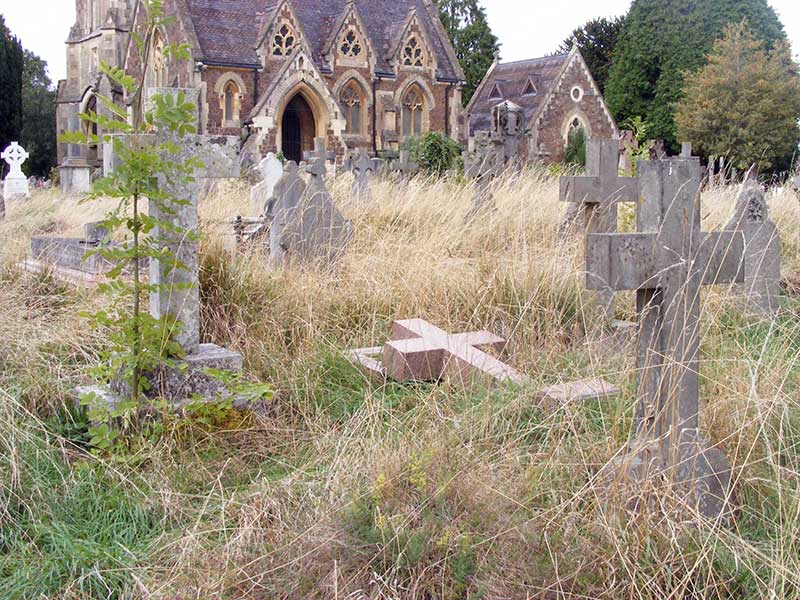
Norman May's memorial
Norman May's memorial is a heavy polished read granite
cross, since toppled and lying against its pedestal. The grave is marked 9
on our plan of the cemetery and lies
on the west side of a grass path running south from near the Speer and
Jenny Lind memorials.
Norman
left a personal estate of £3,322, a considerable sum in those days. Seven
years later his widow Eliza remarried in 1896, auctioneer George Hodgkiss; Eliza
Julia Hodgkiss died at Worcester in 1907 leaving an increased personal
estate of £7,878. Perhaps she had inherited the photographic business after
Norman May's death and continued to derive an income from it?
Newspaper announcements
Knowing the day Norman died, we then visited Great
Malvern library to look for a report in the local newspaper. Norman May's death was reported
(ref 8) in the Illustrated
Malvern Advertiser and General Weekly News, a forerunner of the Malvern
Gazette, on Saturday 22nd June 1889.
A transcription from the microfiche at
Great Malvern Library is below:
Malvern Advertiser Saturday June 22nd 1889
Death of Mr
Norman May
It is our sad duty to record the death of Mr Norman May, which
occurred on Wednesday last at the house of Mr James Nott, Church Street,
Malvern.
In deference to the wishes of friends our notice will be brief, and
it may add to the melancholy interest to remark the particulars given by us
are from notes found in the pocket-book of deceased, jotted down only a few
days before his demise and evidently in the prospect and anticipation of
death.
Mr John Norman Lindley-Norman, more generally known locally as Norman
May, was born in October 1851 and came of an old Norfolk family, more than
one member of which was eminent in the law, and of which the present Lord
Justice Lindley is a relative. He was educated at Plymouth and St Peter's
College, Cambridge, and as he was intending to practise at the Bar, he was
at the time of his death, a member of the Inner Temple.
An extensive
traveller, his letters in these columns, under the nom de plume of 'A
Rambler', were marked by a bright and genial style which exhibited no trace
of the bodily weariness which always accompanies the disease of which he
died.
Debarred by ill-health from taking from taking any very active part in
local matters, his pen was always ready to point out what in his judgement
was not for the public good, and generally with effect.
The founder and one
of the Directors of Norman May & Co Limited, he displayed great business
tact and energy and activity which were intensified and fed by the disease
which was slowly destroying him. Though for a long time ailing, the end came
at length somewhat suddenly. All who were acquainted with Mr May will bear
witness to his courteous and invariably pleasant manner and to his genuine
kindness of heart.
We may just add that, practically, Mr May has for many
years had little to do with the business of which he was the founder. In Mr
Beaufort, a brother Director, he found a perfectly competent coadjutor,
under whose skill and general supervision the concern has been gradually
extending, and which is a pledge of its continuous growth. The funeral takes
place tomorrow (Saturday) at 2.30 in the Cemetery. We offer our sincere
condolences to Mrs May in this painful bereavement.
The following week, the Malvern Advertiser, contained a
short report of his funeral, a solicitor's notice, and perhaps in slightly
poor taste, a lengthy article about the refurbishment of the premises of
Thomas Bennett and Co at the top of Church Street.
The funeral of Mr Lindley-Norman (founder and Director of
the well-known firm of photographers, Norman May & Co) occurred on Saturday
afternoon, at the Malvern Cemetery. In addition to relatives and
representatives of the business in which he had, when in better health, been
the leading spirit; the followers included members of the Freemasons' craft,
as well as tradesmen desirous of thus indicating their esteem for the
departed. The service was impressively read by the Rev L G Smith, Vicar of
Malvern. Deceased had by many admirable qualities won the respect of his
friends and neighbours. He was a comparatively young man – 37 years of age.
Our memoir was given last week.
Also in the paper was a solicitors's notice:
Re John Norman Lindley-Norman
deceased
All persons having
claims or demands against or upon the Estate of John Norman Lindley-Norman
late of Great Malvern in the County of Worcester, Gentleman deceased are
required to send to me the undersigned at my office at No 4 Hollyrood
Terrace Great Malvern aforesaid full particulars of such Claims or Demands
forthwith.
Dated this 27th day of June 1889
WM Lambert, Malvern Solicitor
for the Executrix
Norman's obituary suggests to us that he died of
tuberculosis; in those days tuberculosis was quite common, feared, and
there was no cure for it. It is said that between 1851 and 1910, thirteen
percent of all deaths were caused by tuberculosis, and of those who died in
the age range 20 - 24 forty percent died of tuberculosis.
The 'memoire' in the newspaper suggests Norman may have
been related in some way to Lord Chief Justice Lindley; we have have found
no evidence of that, so possibly he made it up, although we cannot rule out
this information could have been passed down by his mother.
The 'memoire' relates that Norman May had taken on a
business partner, Mr Beaufort, under whom continued growth of the business
could be expected. The reporter was wrong in this respect as Mr Beaufort
left Malvern a year later; see below.
Now follows some information about other photographers
Norman May would have had dealings with during his ten years in Malvern.
The Worcester index of artists 1790 - 1940 lists art
photographer Francis Charles Earl; in 1873 he was at 46 Broad Street
Worcester and 2 Priory Mount, Church Street, Malvern. In 1885 he was at 46
Broad Street only
A Trade directory of 1880 describes him as a photographic
portraitist, miniature painter, landscape and architectural photographer of
46 Broad Street Worcester and Church Street Malvern, a business very similar
to that of Norman May.
This points to Norman May taking over an established
photographic studio, rather starting from scratch, possibly after working
for Mr Earl.
Francis Charles Earl was not the first photographer
to occupy Priory Mount. Thomas Bennett and Son established 1856 was one of
the earliest photographers in Malvern, 1873 artist and photographer at 2
Priory Mount, Church Street and St Ann's Well and at Foregate Street, Worcs.
- advertisement p57 Kelly's Directory 1879. In 1885 photographic and art
studios, 8 Broad Street and Gazebo House, Church Street, Great Malvern. In
1888 at 8 Broad Street only. Business acquired in 1915 by WW Dowty.
Another early photographer was John Down who built a
Camera Obscura at or near St Anne's Well.
The Worcester index of artists 1790 - 1940 lists two
firms connected with Norman May:
-
May Norman, 1879, The Studio, Gazebo House, Church
Street, Malvern, miniature painter on ivory, porcelain etc.
-
May and Stowe, 1879, 37 Tything and Church Street,
Malvern. Advert opposite page 286, Kelly's Directory 1879.
We have not seen Kelly's Trade directory of 1879, but WE
Owens directory of 1880 records:
May and Stowe, photographers, patronished by HRH Prince
of Wales, studio on the ground floor 37 Tything, and Norman May Church
Street Malvern.
In fact the partnership between May and Stowe had been
dissolved the year before. The London Gazette August 29th 1879 reported:
Notice is hereby given that the partnership between
Norman John May and Edwin Drury Stowe at no 37 Tything in the city of
Worcester under the title May and Stowe photographers has been dissolved by
mutual consent.
Dated 16th day of August 1879
Norman John May
Edwin Drury Stowe
Edwin Drury Stowe was an established photographer, 5
years older than Norman May, and perhaps Edwin helped Norman establish the
photographic side of his business.
Edwin Drury Stowe was born in Cheltenham in 1846, the son
of Commission Agent James Stockford Stowe. Trade directories record him
living in High Street Tewkesbury for most of the 1870s, where he is at the
time of the 1871 census.
In 1885 he was a photographer of 8, Castle Street
Cirencester. By 1898 he had moved on again and he and his son Drury, who was
born at Tewkesbury in 1875, were renting premises at 72 High Street, Bedford.
The National Archive lists accommodation relating to the
lease of the premises at Bedford, which gives an indication of the extensive
equipment needed to run a photographic business at that time. To quote:
Messuage and shop, with studio, outbuildings and garden
being no 72, High Street, Bedford, now in occupation of Edwin Drury Stowe.
Fixtures, as in schedule
Term - 9 years and 72 days from 1 March 1899
Rent - £130 p.a.
Premises to be kept in repair and painted on outside
every 3rd year and interior twice during said term.
No trade except that similar to present to be carried on
on on premises without licence in writing of i) ...... term may cease on 11 May
1901 if 3 months notice given.
Schedule:
Artist Room. Negative rack, shelves etc.
Negative Room. Negative box rack, shelves, bench etc. Copying Room. Camera
Rack. Negative box rack, shelves, painted cabinet etc.
Printing Room. Shelves, frames, high pressure taps etc.
Printing House. "The structure 11 feet 2 inches x 5 feet
6 inches with glass roof, inside table and fittings".
Dark Room - Upstairs. Bench, shelves, galvanised iron
tank, chemical cupboard etc
Dark Room - downstairs. "The Structure with shelves,
sink, gas and water fittings"
Studio. "One radiating stove with flue pipe"
Also mentioned: dressing room, greenhouse, WC under
studio, pantry, wood cupboard under stairs, china cupboard, cellar,
scullery, cellar, kitchen, passage, shop - south window, north window, south
side of shop, dining room, hall, WC; WC in basement, drawing room, back
bedroom, dressing room, stair landing, front bedroom, small front bedroom,
back bedroom, servants bedroom, landing, entrance passage.
Witness Henry Tebbs, solicitor, Bedford Date: 11 March
1899.
Photographer Edwin Drury Stowe died in 1901 aged 55
years; the 1911 census recorded that his son Drury Stowe became a leather
manufacturer.
We have identified Norman May's second business partner as John
William Beaufort, born at Bradford in 1864. He was the third son of 'Tinner'
John and Martha Boocock; his mother died soon after he was born and his
father married in 1881 Eliza Turner.
The 1881 census recorded John as an artist, living at
home. In 1889 he married Lucy Anne Ostcliffe, the daughter of an innkeeper,
at Bradford Cathedral. At some stage, prior to his marriage, he had
obviously changed his surname, no doubt in order to advance his career. His
marriage certificate confirms that he was a photographer living at Priory
Mount, Malvern.
About 1890, after Norman May's death, John went to work
for the famous photographic firm
Elliott and Fry, in Birmingham and he became Managing Director from 1915
to 1926.
In 1893 he had joined the Freemasons (St Paul's Lodge,
Birmingham).
John and Lucy had two sons, Percival Stanley born at
Malvern in 1890 and Harold Ostcliffe, born at Birmingham in 1894.
During WWI, Percy Stanley Beaufort joined the Artists Rifles as a
Private, and in 1917 was transferred into the Royal Flying Corps as a
communications equipment officer. He survived the war and in 1920 was living
in Birmingham.
Sadly his younger brother 2nd Lt Harold Ostcliffe
Beaufort, 1/6th Battalion, The Prince of Wales’s (North Staffordshire
Regiment) was killed in action on the 13th October 1915 just seven days
short of his 21st birthday. He had attended
Wrekin College
and
another website records his story and that of others who lost their lives in
WWI.
After WWI, John William Beaufort is noted to have painted a
portrait of famous naturalist
Alfred Russell Wallace (1823 - 1913) who was a contemporary of Charles
Darwin. The painting was based on a photograph of Wallace taken in 1903 by
the photographic firm Elliott & Fry; the painting was presented to the
Natural History Museum in 1923,
click to read report in Times.
John William Beaufort, artist and photographer, died at
Weybridge in 1943.
The local reference section of Great Malvern library
holds a great deal of information about the history of the town, including
old maps, newspapers on microfiche, trade directories, and histories written
in more recent times. Amongst these is a little gem, 'Norman May's Guide to
Malvern' first published about 1884. The library copies may have been
rebound, as the original guide, priced one shilling, had patterned not plain covers.

It is a pocket sized book containing the advertisements
of shop-keepers, hotels and boarding house keepers, maps, illustrations and
information about the town, where to go and what to see. The title page (see
front-piece below) says the guide is illustrated with maps, plans, woodcuts
and photographs. In fact there are only two photographs and these are glued
into the book. One is of a young girl (we wondered who she was) and the second is a photograph taken from
the tower of the Priory church, looking across the top of Church Street and
Belle Vue Terrace towards North Hill.
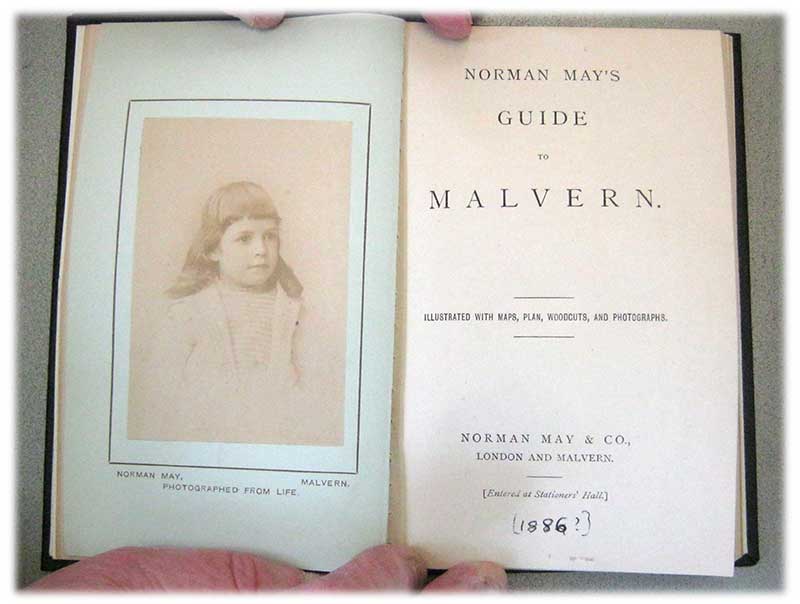
A better copy of the view towards North Hill (shown
below) is held by Malvern Museum. Click photo to enlarge.
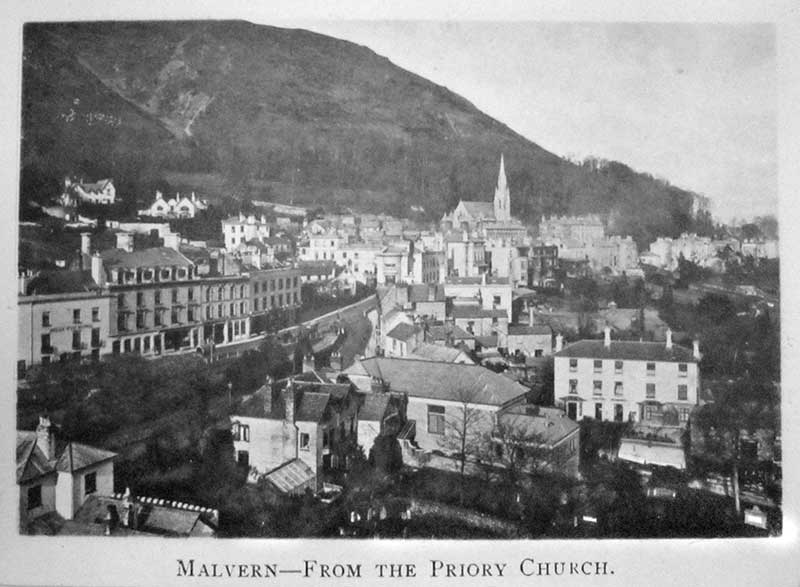
The remainder of the illustrations were most probably produced from
woodcutt engravings; for example see the illustration of the Abbey Gateway
below.
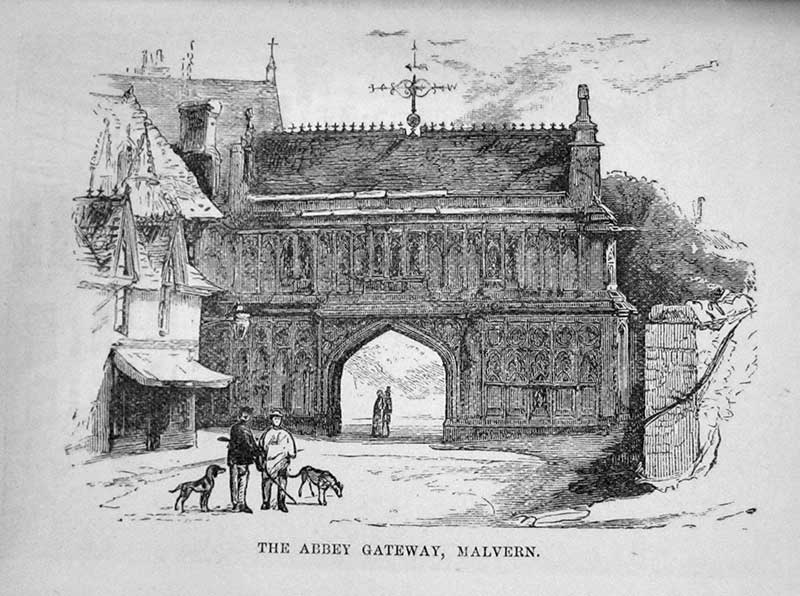
One page shows the map of Malvern as it was circa 1886,
see below. The road system is very similar 130 years later but there are
some points to note. Court Road was in Victorian times named Pool End
Street, and Clarence Road was named Mill Lane. Avenue Road seems only to
come down as far as Great Malvern station, and so we wonder if the lower
half of Avenue Road below the station was built later. Click image to enlarge.
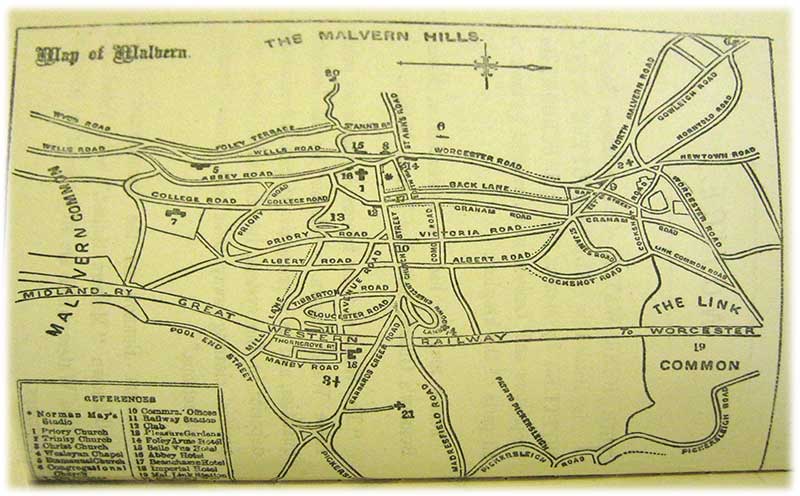
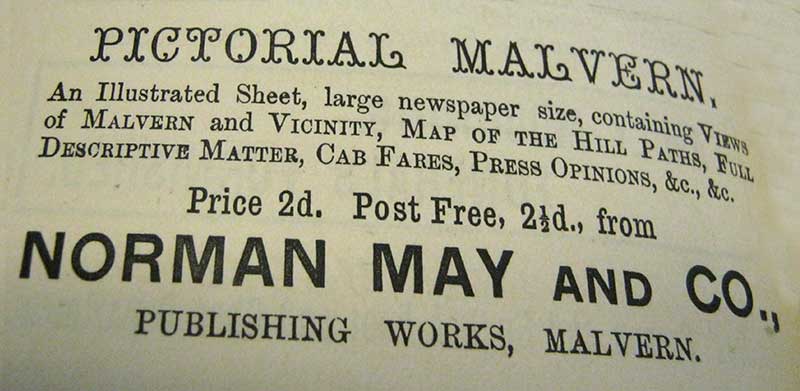 In
the guide are two advertisements for Norman May's Studio. One, shown at the
top of this article, is a full page advertisement which appears at both the front and back of the
guide largely repeating the information in the trade directory of 1884.
The second, shown opposite, is an advertisement for an illustrated Pictorial
sheet of Malvern. The advertisement reads: In
the guide are two advertisements for Norman May's Studio. One, shown at the
top of this article, is a full page advertisement which appears at both the front and back of the
guide largely repeating the information in the trade directory of 1884.
The second, shown opposite, is an advertisement for an illustrated Pictorial
sheet of Malvern. The advertisement reads:
Pictorial Malvern
An illustrated sheet, large newspaper size, containing views of Malvern and
vicinity, map of the hill paths, full descriptive matter, cab fares, press
opinions etc.
Price 2d, Post Free 2 1/2d, from
Norman May and Co
Publishing works, Malvern
If you are interested to learn more about the history of the area you
will find Norman May's Guide to Malvern a good read.
According to his birth certificate, confirmed by a record of the
students of Cambridge University, Norman John May was born at Norwich on
13th October 1851. The 1861 census records him as the son of Henry John and
Hannah May then residing in Cambridge at 16 Church Street. Henry John May is
then
described as an Artist (portrait).
Norman May's mother was born in Norwich, and it's
possible she either named her son after a former mayor John Norman (1657 -1724) who
being childless left a trust for the education of his near relatives, now
known as
Alderman Norman's Foundation, or her brother, John Norman Harris.
The census records tell us Norman John May (the eldest
child) had three brothers and a sister. Norman and his youngest brother
Walter were the only ones to marry and, as far as we know, they had no children.
Norman and his siblings were short lived and we think it
likely that they all died of
tuberculosis.
Father
Not much is known about Norman's father who on the birth
certificate, and in the 1851 census, is recorded as schoolmaster John May,
and later as Henry John May.
The 1851 census recorded a schoolmaster, John May,
living with wife Hannah in Little Bull Street, in the St Paul's district of
Norwich.
We had not found a record of John May's marriage in the
Ancestry copy of the index of marriages, but later discovered a marriage listed
in Free BMD, which was registered Norwich in the first quarter of
1851, Vol 13, Page 441. Local historian Chris Bannister has obtained a copy
of the marriage certificate that confirms that school teacher John May and
Hannah Harris, both of Cowgate Street, St Paul's, Norwich married on 1st
January 1851 (ref 11).
John May's father was recorded as Thomas May, a farmer;
but as we have been unable to find him in the records, this sheds little
light on how John May first became a schoolteacher. Hannah's father was
described as John Harris, a dyer.
We don't know at what school John taught, or what
subject; nor do we know what caused John to become an artist - a change of
career which would have been considered a risky venture bearing in mind he
had a wife and children to support, unless of course he had capital to
fall back on.
Perhaps John May studied part time at the
Norwich School of
Design, which had been founded in 1845 by followers of the Norwich School of
Painters; nowadays Norwich University of the Arts. Possibly also, through
his wife's family, he had met artists engaged in the design, colouring and
printing of fabrics.
Henry John May appears twice in the 1871 census.
In one record he is listed with his wife and children at
21 Longfield Terrace, Plymouth, Devon where he is described as an Artist
(Eng); possibly an engraver.
In a second record he is residing in East Street,
Ashburton, some 20 miles north east of Plymouth, describing himself as an
Artist and Photographer; with him is his son Thomas aged 17 years, also
described as a Photographer, suggesting that on census night they could have been away from
home on business.
The index of deaths records Henry John May died at Plymouth in 1878 aged 56 years.
Mother
We think Norman's mother Hannah Priscilla Harris (1826 - 1887) was
baptised Anna Priscilla Harris at St George's church, Colegate, Norwich on
22nd October 1826.
She was the eldest child of Bombazine Dyer, John Harris
and Ann Cox. Bombazine, now obsolete, was a woven fabric used to make
ladies' dresses.
Hannah had a sister Priscilla, and four brothers, Joseph Peter, Samuel Ebeneezer, John
Norman, and Norman Atterton. Sadly Hannah's mother died in 1841 following
the birth of Norman Atterton and he died the next year. Hannah's father died in 1849 and
so the family was forced to split up.
Hannah married John May; Priscilla, a
governess and a witness at Hannah's wedding, went to live in Hertfordshire with her aunt Zilpah who had
married farmer Thomas Cornwell; Joseph Peter (1831 - 1892) married Amelia
Sarah Wood in 1857 and became a schoolmaster; Samuel (1838 - 1911) went to
live with his married uncle Ebeneezer in Colchester who was a Dyer, before
marrying and eventually becoming a mercantile clerk. The 1851 census records
that John Norman Harris (1840 - 1899), described as an orphan, was taken in
by Norwich accountant John Barnard and his wife Charlotte; he became a
chintz glazer and in 1860 married Maria Snell Doran, the daughter of chintz
glazer John George Doran.
Hannah and her husband, John, seem to have moved around a fair
bit. In 1851, newly married, they were living in Norwich; in 1853 they were in
Kent; in 1861 they were in Cambridge, and in 1871 the family was in
Plymouth. The 1881 census records Hannah, now a widow, still living in
Plymouth at 44 Park Street, three years after her husband's death, with
three of her children: Frederick, a photographic retoucher, Rosa, a photographic colorist,
and Walter, an assistant librarian.
Hannah died at Fulham in the last quarter of 1887, not
long after her unmarried daughter Rosa, who had died at Fulham in the second quarter of
that year.
Siblings
None of Norman's siblings lived into
middle age, suggesting either an illness such as tuberculosis, a hereditary
factor, or poisoning from photographic chemicals - tuberculosis seems to us
to be the most likely explanation.
Norman John May, the eldest, was born at Norwich on 13th October 1851 and
died at Great Malvern on 19th June 1889 aged 37 years.
Thomas Henry May was born at West Malling Kent about
1854. The 1871 census recorded him as a photographer aged 17 years. Very
sadly the National Probate Calendar records that photographer Thomas Henry
May died shortly before his father on 5th April 1878 at 6 Marina Terrace,
Plymouth. His executor was his eldest brother Norman then a photographer of
16 Chestnut Walk, Worcester.
Frederick Joseph May, who was born West Malling Kent about
1856, died at Reading in 1890 aged only 34 years.
Rosa Alice May who was born at Cambridge about 1861, died
at Fulham in 1887 aged only 26 years; her mother Hannah died the same year.
Walter Harris May, the youngest, who was born at
Plymouth, Devon, about 1865, died at Chelsea in 1891 aged only 26 years. Some
weeks earlier the 1891 census had recorded photographer Walter May and his
wife Edith, born Southwold, Suffolk, staying in Great Malvern at Norfolk
Villa on the Worcester Road. Perhaps either Walter had come for the water cure, or to visit his brother Norman's
widow, or he had inherited an interest in Norman May's studio.
Connection to the family of Lord Justice Lindley
We have searched for a direct connection between the
families of Norman May and Lord Justice Lindley and found none. It seems
very unlikely they were either first or second cousins, so if there were a
connection it was further back.
Sir
Nathaniel Lindley (1828 - 1921) was born on 29th
November at Acton. His father was the famous botanist
John Lindley who was
born at Catton, Norfolk in 1799, the son of nurseryman George Lindley and
Mary Moore.
Perhaps there was a connection of the female lines going
back possibly to the wider family of John Norman, mayor of Norwich, but we
will leave that for others to investigate!
The photographic business known as Norman May's Studio
continued to trade for many years after Norman's death.
On 12th December 1891 an advertisement appeared in
the Malvern Advertiser, of which the following is a transcription:
Norman May and Co Limited
(under new management)
Photographers to the Royal Families of England and Spain
and leading European Governments
12 and 13, Church Street, Malvern
and at 23, Promenade Villas, Cheltenham.
Specialities: Finely executed oil paintings direct
on canvas; Highly finished coloured Porcelain Photographs;
Photo – Engraving
Book Illustration by Photography
Plan reproductions for Engineers, Architects, Engravers
etc
Frames in all styles; Leather and Ormolu Cases; Albums;
Screens etc
Local views
Largest stock in the country
Later, a trade directory of 1924 records,
Norman May's Studio, Church Street, Great Malvern and
Hereford TN 135
A directory of 1932 simply records,
May's Studio, Church Street, Great Malvern
We have been told that in the 1950s Norman May's had a
studio above Belle Vue Terrace, where there is a picture framer now.
The 1983 telephone directory (ref 10) records,
Norman Mays, photographer and photographic dealers,
241 Worcester Road, Malvern Link, Telephone 4522.
Nowadays 'Norman Mays' is a business based in
Worcestershire, specializing in schools' photography. Roy McAdam has very
kindly sent information about owners of the business between 1945 and the
present time (ref 12), but ownership during the period 1889 - 1945 remains a
mystery.
Do let us know if you can add to this account, or have a
photo of either Norman May or his business partner John Beaufort.
- Burial register of Great Malvern cemetery
- National Probate Calendar
- Birth certificate of Norman May; communication C Bannister, May 2016
- Biography of Cambridge Alumni
- Index of births
- England and Wales Census
- Kelly's and WE Owens Trade Directories
- Obituary of Norman May, Malvern Advertiser, June 22nd 1889
- Index of deaths
- Telephone directory 1983
- Marriage certificate of John May; communication C Bannister, May 2016
- Communication from Roy McAdam May 2016
- Communication from Roger Hall-Jones June 2016
- Communication from Steve Frost February 2017
- London Gazette 1910
- Communication from Dawn Heuston, October 2021
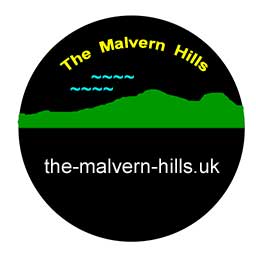
Back to top
|
